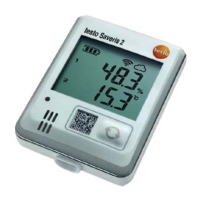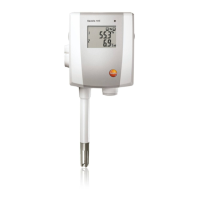6 Using the product
114
• Select the Index range if the readings in particular rows in
the table are to be marked.
- The selection lists are enabled for the determination of the
index range.
3. Determine time period or index range.
4. Click on [OK].
- The dialogue is closed and the corresponding readings are
marked in the table.
The selected readings can be copied and further edited
using suitable software (e.g. with Microsoft® Excel
®
).
Pos: 143 /TD/Produ kt verwenden/testo Sa veris/05b Tabellen a nalysieren/02 Markier ung aufheben @ 0\mod_1188 996637078_79.doc x @ 3575 @ 4 @ 1
6.5.2.2. Dropping the marking
> Click on Edit | Tools | Drop marking.
- The marking of the readings is deleted.
Pos: 144 /TD/Produ kt verwenden/testo Sa veris/05b Tabellen a nalysieren/03 Extre mwert oder Mittelwert einf ügen @ 0\mod_1188996637 890_79.docx @ 3585 @ 4 @ 1
6.5.2.3. Inserting extreme values or mean in the table
Insert the minimum/maximum reading as well as the mean from the
whole table at the end of the table.
1. Click on Edit | Tools | Extra lines | Minimum, Maximum or
Mean value.
- A row with the corresponding value for all readings is inserted at
the end of the table.
> Repeat step 1 to insert another value in the table.
To erase a value from the table again, click in the Extra
lines menu again on the corresponding entry.
Pos: 145 /TD/Produ kt verwenden/testo Sa veris/05b Tabellen a nalysieren/04 Verdi chten @ 0\mod_1188996638 437_79.docx @ 3595 @ 4 @ 1
6.5.2.4. Compressing readings
Compress the table to definable intervals to maintain the clarity of
the table with large amounts of data.
Only the first and the last value are shown for the individual
intervals. The other readings are hidden.
In addition, the minimum, maximum and/or average value can be
shown for the respective time period.
1. Click on Edit | Tools | Compress.
- The dialogue for determining the options is opened.

